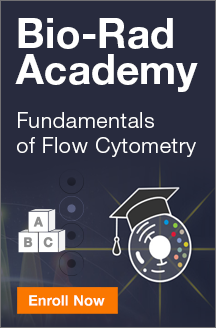-
US | en
- Products
- Applications
- Flow Cytometry
- Flow Cytometry Explained
- Flow Cytometry Basics Guide
- Chapter 4 - Controls in Flow Cytometry
- Single Staining and Compensation Controls

Single Staining and Compensation Controls
As mentioned in Chapter 2 when performing multicolor flow cytometry, single stained samples are essential to determine the levels of compensation. Single staining will reveal the level of spectral overlap between different fluorophores and allow you to remove or compensate for this overlap (Chapter 2, Figure 12). This can be seen in Figure 21a where the fluorescence of FITC can be detected in the PE channel. Figure 21b shows how the data looks when properly compensated. This spectral overlap should be compensated for every fluorophore used.
Staining Rules
The important rules to remember when using single stained samples for compensation are:
-
The staining of the compensation control must be as bright as or brighter than the sample. Antibody capture beads can be substituted for cells and one fluorophore conjugated antibody for another, as long as the fluorescence measured is brighter for the control. The exceptions to this are tandem dyes, which cannot be substituted.
Note: Although it would seem safe to assume that all tandem dyes created with the same donor and acceptor would have the same emission, this is not the case. Tandem dyes from different vendors or different batches must be treated like separate dyes, and a separate single-stained control should be used for each because the amount of spillover may be different for each of these dyes.
-
The compensation algorithm needs to be performed with a positive population and a negative population. Whether each individual compensation control contains beads, the cells used in the experiment, or even different cells, the control itself must contain particles with the same level of autofluorescence. The entire set of compensation controls may include individual samples of either beads or cells, but the individual samples must have the same carrier particles for the fluorophores.
-
The compensation control must use the same fluorophore as the sample. For example, both GFP and FITC emit mostly green photons, but have vastly different emission spectra. You thus cannot use one of them for the sample and the other for the compensation control.
- Enough events must be collected for the software to make a statistically significant determination of spillover. About 5,000 events for both the positive and negative population is ideal, but less can be used if necessary.
